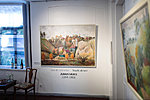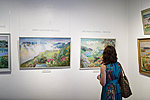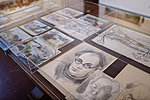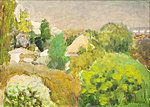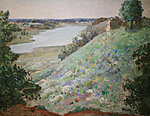3.06.-4.09.2019
"View from the window". 120th anniversary of the birth of artist Juhan Muks (1899 – 1983).
The scenic views of Viljandi and its surrounds were the main source of inspiration for artist Juhan Muks. His paintings of Lake Viljandi followed the principles used by the French artist and founder of impressionism Claude Monet. Both artists painted one scene at different times. Monet’s best known painting of the port of Le Havre at sunrise “Impression. Sunrise” (1872) was painted from the window of the artist’s home; Muks also painted his views of Lake Viljandi mostly from his home window.
Born into the family of an average farmer at Tuhalaane parish, Viljandi County in Estonia, the artist started his art studies without his parents’ advice or support. Despite his modest background, Muks managed to participate in nearly all of the most important art courses in Estonia as well as in several international art centres.
From 1919 to 1925 he studied under the instruction of Konrad Mägi and Ado Vabbe at the Pallas School in Tartu, and for a year, 1921–1922 in the Art Academy of Latvia in Riga. In 1925 and 1926 Muks received a scholarship from the Pallas Higher Art School to attend free academies in Paris. Europe’s most forward-looking art metropolis enabled Muks to get familiar with different art movements (impressionism, cubism etc.): he studied in three or four free studios with different study methods and instructors. Above all, he learned to endlessly analyse himself, and acquired the determination to be constantly in a good creative shape. He remained true to this principle all through his life – typical of a master for whom keeping in good shape is a continuing process, an unchanging creative routine.
The 1930s were for Muks also the years of breakthrough in his home town Viljandi. From 1933 to 1939 he lived and worked near Paris in France. He came back to Estonia and settled in Viljandi just before the Second World War. Having returned from Paris, he plunged into the art life of his home town, participating in the seventh and eighth art exhibitions in Viljandi (1942 and 1943) during the German occupation. Early in the Soviet period in 1946 Muks was the chief organiser of the ninth Viljandi art exhibition, which remained the last for a longer period.
Viljandi’s lively art life of the 1930s suffered serious setbacks at the beginning of the Soviet occupation. The complicated situation of the Soviet period affected Muks’ possibilities in personal and creative life, but not his palette: his paintings still expressed the early 20th-century painting tradition, with added innovative features, materials and the spectrum of colours of various decades, as well as the art canons of the new regime. In the 1950s Muks fell out of favour.
After he was reinstated as member of the Estonian Artists’ Association in 1960, Muks immediately exhibited his works in Viljandi (in 1961 and 1962). Muks was painting actively again but he was for some time unable to influence the art scene in his home town, because of an active boom in amateur art. Since 1967 Muks took part in almost every all-Estonian exhibition in Tallinn and Tartu. His works repeatedly attracted general attention. Although the artist made his comeback in his senior years, he managed to draw attention with his creations, he was reckoned with and his exhibitions were eagerly anticipated by the art lovers of Viljandi.
In 1979 Muks was the first painter in Estonia to receive the highest recognition in landscape painting – the Konrad Mägi Medal and the accompanying cash award. He got the award for the best landscape of 1978, “Viljandi in Early Autumn”. “Juhan Muks is currently one of the greatest landscape artists in Estonian art,” art critic Eha Ratnik wrote on the occasion of the award.
The
best examples of Muks’ works are landscapes and views of Lake
Viljandi, which even today inspire curators to display his paintings.
The introductory text to the exhibition “The Painter of Viljandi
Juhan Muks (1899–1983)”, held in Adamson-Eric Museum in 2013,
admits that “Juhan Muks is one of those Estonian artists who have
been unjustly overlooked”.
Tiiu
Männiste
The
exhibition was supported by the Estonian Cultural Endowment.
%20(1)-1.jpg)
